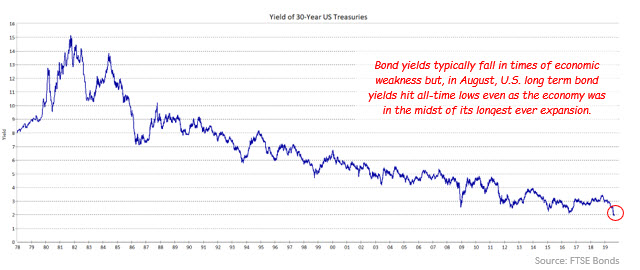Keep connected
Our investment management team is made up of engaged thought leaders. Get their latest commentary and stay informed of their frequent media interviews, all delivered to your inbox.
Jeff Herold
September 10, 2019
Internationally, there were several indications that economic growth was slowing. Chinese industrial production grew only 4.8% over the past year, the slowest pace since 2002. Weaker manufacturing output was the primary culprit. In Europe, data showed its largest economy, Germany, actually contracted in the second quarter, leading to concerns that a recession was unfolding. Central banks in New Zealand, India and Thailand all announced larger-than-expected cuts to interest rates on the same day in early August, in response to worries of slowing growth, while other central banks hinted at future monetary easing. Global bond yields fell in response.
By the end of the month, a remarkable $16 trillion of government bonds globally had negative yields as investors sought some protection from weakening economies. In Germany, Netherlands, and Switzerland government bonds of all maturities (i.e. from 1 year to 30 years) traded with negative yields. In Germany, for example, a 10-year Bund yielded -0.70% at month end, implying investors were willing to accept a guaranteed loss for a decade. Not surprisingly, the positive yields of Canadian bonds, albeit low, seemed attractive to international investors faced with negative yields in their own markets. Investment dealers reported significant buying of Canadian bonds by international accounts in the month.
Canadian yields across all maturities fell sharply in August. The yields of 2 and 30-year Canada bonds dropped 20 and 27 basis points, respectively. Mid term issues saw even larger declines in their yields, with 5 and 10-year yields falling 27 and 33 basis points, respectively. The larger move in mid term yields reflected investors’ belief that the Bank of Canada would eventually lower interest rates multiple times in reaction to weakening economic conditions. Yields of 2-year bonds were stickier because of the greater comparability with Treasury Bills that reflected the Bank’s as yet unchanged overnight target rate of 1.75%. The shifts in Canadian yields were broadly similar to the moves in other markets, such as Germany’s, but they paled in comparison to the drop in U.S. yields during August. The yield of 2-year Treasuries fell 38 basis points, while 30-year Treasuries plunged 59 basis points to record lows below 2.00%.

Our investment management team is made up of engaged thought leaders. Get their latest commentary and stay informed of their frequent media interviews, all delivered to your inbox.